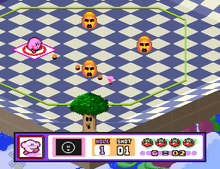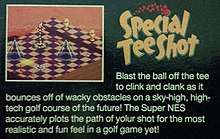Kirby's Dream Course
Kirby's Dream Course[lower-alpha 1] is a miniature golf video game developed jointly by HAL Laboratory and Nintendo EAD and published by Nintendo for the Super Nintendo Entertainment System in 1994. It is one of four Kirby video games released for the console. It was re-released on the Virtual Console in 2007 for the Wii and in 2013 for the Wii U. Nintendo re-released Kirby's Dream Course in Europe and North America in September 2017 as part of the company's Super NES Classic Edition.[1] It was also released on the Nintendo Switch Online SNES app on the Nintendo Switch in 2019.
| Kirby's Dream Course | |
|---|---|
 North American boxart | |
| Developer(s) | HAL Laboratory Nintendo EAD |
| Publisher(s) | Nintendo |
| Director(s) | Takashi Saito |
| Producer(s) | Shigeru Miyamoto Satoru Iwata Yasuhiro Sakai Takao Shimizu |
| Composer(s) | Hirokazu Ando |
| Series | Kirby |
| Platform(s) | Super NES |
| Release |
|
| Genre(s) | Sports |
| Mode(s) | Single-player, multiplayer |
Gameplay

Kirby's Dream Course is a golf video game which is viewed from an isometric perspective. Instead of a ball, the player tries to hit Kirby around the course and into the hole at the end. Players must set the power, angle, and spin to connect with various enemies found throughout the levels. Once only one enemy remains, that enemy will transform into the hole. The different abilities that Kirby can obtain from many of the enemies make up a large part of the game, often being required for completion of a hole. These abilities include Kirby turning into a tornado (that can be steered), a sparkly ball (that can destroy certain obstacles), and a UFO (which allows Kirby to float and move at will for a short time). Other abilities include Kirby being able to slow down / float with a parasol, as well as stop completely as a stone, which will slide down slopes, or a porcupine, which will stay put.
The game has eight single-player courses, with eight holes on each. There is a high score board for each level, with medals to be won on each of them. The player can unlock extra features (such as alternative versions of the courses) by winning the medals. There are Bronze, Silver, and Gold medals to be won, which are awarded to Kirby at the end of the course. There are also four two-player courses (again with eight holes). The final hole is listed as "Dedede" and features King Dedede in a large machine that continually moves toward Kirby while deploying smaller versions of himself as the final boss.
Kirby loses one of his health points (represented as a tomato icon in single-player, and a square with rounded edges in two-player mode) every time he makes a shot or gets hit by an enemy or an obstacle, and gains one every time he hits an enemy or lands in a hole. In the two-player mode, two health points are awarded for landing in the hole first, and two health points can also be lost if one player's Kirby is "attacked" by the other player's by using an ability (such as the tornado or the stone). In the single-player mode, Kirby loses one life when all his health points are gone or fall off the stage and when he runs out of lives, the game will end. Afterwards, the player can either continue from the beginning of the course or exit it. In the two-player mode, the loss of all health points causes that player to miss a turn, as their Kirby falls asleep. This is referred to colloquially as a 'cake nap' because the animation often depicts Kirby dreaming of a slice of cake with a cherry on top. These nap animations also include a wrapped candy and an ice cream cone.
Development

Kirby's Dream Course began as a miniature golf game entitled Special Tee Shot, which eventually released in Japan only on the Satellaview add-on. It was only midway through development that the developers retooled it with elements from the Kirby series. By this time, it had the working title "Kirby's Tee Shot".[2] The development team comprised a mix of staff from HAL Laboratory and Nintendo EAD. The game was featured on some Super Nintendo packaging featuring a Special Tee Shot logo.
Reception
Kirby's Dream Course received positive reviews, garnering an aggregate score of 77.00% on GameRankings based on seven reviews.[3] In their review, IGN concluded that Kirby's Dream Course is a "quirky, goofy, but all-around satisfying game to play."[4] Nintendo Life offered a similar assessment, awarding the game 8 out of 10.[5] GamePro called Kirby's Dream Course a "wildly amusing game" which "does for golf what NBA Jam did for basketball." They praised the game for adopting a golf theme while faithfully recreating the Kirby style in its gameplay, graphics, and sounds.[6]
Next Generation reviewed the SNES version of the game, rating it four stars out of five, and stated that "If you can keep from choking on the saccharin, this games is so unique it rates at four stars just for being unlike anything we've seen."[7]
Notes
- Known in Japan as Kirby Bowl (カービィボウル, Kābī Bōru)
References
- "Super NES Classic Edition". Nintendo of America, Inc. September 29, 2017.
- "Electronic Gaming Monthly 65 Releases". Electronic Gaming Monthly. No. 65. Sendai Publishing. December 1994. p. 278.
- GameRankings. "Kirby's Dream Course for Super Nintendo".
- Thomas, Lucas M. (July 31, 2007). "Kirby's Dream Course Review". Retrieved June 5, 2016.
- Calvert, Darren (June 30, 2007). "Review: Kirby's Dream Course (SNES)". Retrieved June 5, 2016.
- "ProReview: Kirby's Dream Course". GamePro. IDG (70): 80. May 1995.
- "Finals". Next Generation. No. 5. Imagine Media. May 1995. p. 101.